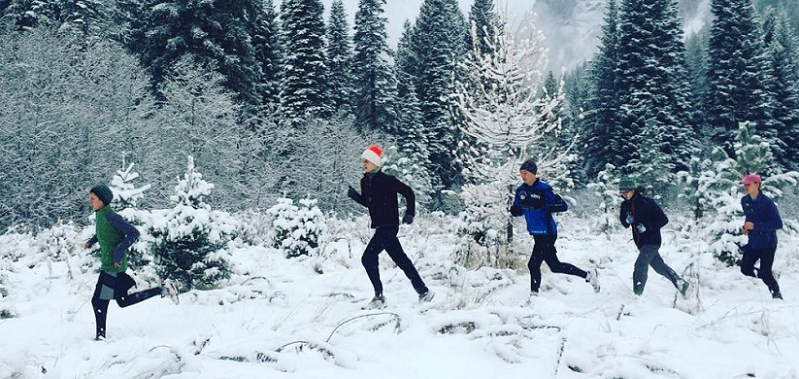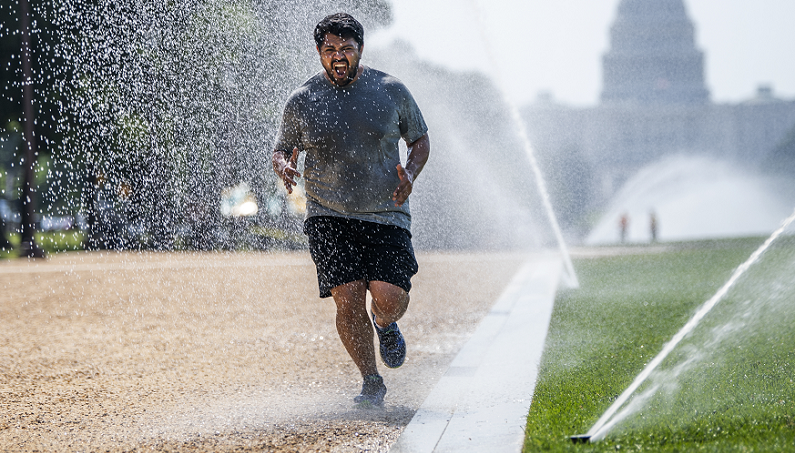
The forces of nature, specifically, extreme hot and cold conditions, can significantly affect your training outcomes and physical performance. Here we look at the complexities of the human body’s thermoregulatory system and how temperature extremes challenge it, influencing your endurance, strength, and recovery.
Contents
- Introduction to Extreme Weather and Workout Performance
- The Science Behind Weather and Physical Performance
- Impact of Hot Weather Conditions on Workout Performance
- Impact of Cold Weather Conditions on Workout Performance
- Dealing With Variable Weather Conditions
- The Psychological Impact of Weather on Workout Motivation and Performance
- References
Introduction to Extreme Weather and Workout Performance
Whether you are an avid gym-goer, a professional athlete, or someone who enjoys a casual jog around the neighborhood, the weather can significantly impact your exercise routine. From the blistering heat of summer to the biting cold of winter, extreme weather conditions present unique challenges to maintaining and optimizing our fitness regimes.
Brief Overview of Extreme Weather Conditions
Extreme weather conditions span a broad spectrum, from sweltering heatwaves and high humidity to icy temperatures and biting winds. These extremes can also include sudden fluctuations in weather, such as an unexpected downpour during a run or a swift drop in temperature as the sun sets. Each of these situations poses a distinct challenge to the body, demanding different physiological responses and adjustments.
Connection Between Weather Conditions and Workout Performance
Weather conditions can significantly impact workout performance, affecting everything from our body’s thermoregulation to our mental motivation. The heat can lead to quick fatigue and dehydration, while the cold can stiffen muscles and affect respiratory function. On a psychological level, daunting weather can dampen our motivation to begin a workout, or it can present an additional hurdle to overcome during exercise. Understanding these challenges is the first step to developing effective strategies to mitigate the impact of extreme weather conditions on your training routine.

The Science Behind Weather and Physical Performance
Before we delve into the specific impacts of hot and cold weather on workout performance, it’s essential to lay the scientific groundwork. By understanding how our bodies respond to temperature extremes and the role of our thermoregulatory system, we can better appreciate the challenges and devise effective strategies to deal with them.
The Role of the Body’s Thermoregulatory System
At the heart of our body’s response to temperature extremes is the thermoregulatory system. This complex physiological system maintains a delicate balance, ensuring our body temperature stays within a safe range, typically around 98.6°F (37°C). The skin, blood vessels, and sweat glands work together to release heat when our body temperature rises, such as during exercise or in hot weather [1].
In contrast, our body conserves heat when it’s cold by reducing blood flow to the skin and shivering to generate heat. Any disruption to this balance can strain our body, affecting our physical performance and safety.
Understanding the Human Body’s Response to Temperature Extremes
Extreme temperatures challenge our thermoregulatory system. In high heat and humidity, our bodies work harder to cool down, resulting in excessive sweating, increased heart rate, and in extreme cases, overheating. On the other hand, cold temperatures cause our bodies to work harder to maintain warmth.
Blood vessels constrict to preserve heat, which means less oxygen-rich blood reaches the muscles. Moreover, our bodies may also shiver to generate heat, which can affect muscle control and coordination. These physiological responses can all impact workout performance [2].
The Impact of Humidity on Hydration and Body Temperature
Humidity, or the amount of moisture in the air, can further complicate how our bodies respond to temperature. High humidity can make it harder for sweat to evaporate from our skin, which is our body’s primary cooling mechanism. This inefficiency can cause body temperature to rise faster during a workout, leading to quicker fatigue and even heat-related illnesses.
On the flip side, low humidity, often encountered in cold, wintry air, can cause quicker dehydration and dry out our airways, potentially affecting respiratory function during exercise. Thus, humidity is an important factor to consider when assessing the impact of weather on workout performance.
Understanding the science behind our body’s response to weather conditions can help us make more informed decisions about how, when, and where to exercise. It allows us to appreciate the challenges we face during extreme weather conditions and guides us in taking the necessary precautions [3].

Impact of Hot Weather Conditions on Workout Performance
Now that we have a solid understanding of how our bodies respond to temperature and humidity, let’s explore how these responses affect our workouts, starting with hot weather conditions. The sweltering heat can make any exercise feel like an uphill battle, but it does more than just cause discomfort. It impacts our physical capabilities and can present serious health risks if not addressed properly.
The Effects of Heat on Endurance and Stamina
When temperatures rise, our bodies need to work harder to keep cool. This process diverts blood flow away from our muscles towards our skin, as an attempt to dissipate heat. The result is an increase in heart rate and a decrease in blood pressure. Consequently, our endurance levels and stamina can take a hit as we tire out more quickly than in cooler conditions. Moreover, heat can increase glycogen depletion rates, leading to a faster onset of fatigue.
Impact on Muscle Performance and Recovery
Heat doesn’t just affect endurance; it can also impact muscle performance. High temperatures can speed up the onset of muscle fatigue and potentially increase the risk of muscle cramps due to dehydration and salt loss from excessive sweating. Furthermore, heat can slow down recovery post-workout. A high body temperature post-exercise can cause additional stress on the body, extending recovery time and potentially affecting subsequent workouts [4].
Safety Concerns and Risks: Heat Exhaustion and Heat Stroke
Above all, exercising in hot weather can pose significant health risks if precautions are not taken. Heat exhaustion, characterized by heavy sweating, rapid pulse, dizziness, and fatigue, can quickly progress into a potentially fatal heat stroke if ignored. Heat stroke, a condition where the body’s temperature regulation fails, is a medical emergency requiring immediate attention. Therefore, recognizing the signs of these heat-related illnesses is crucial when working out in hot conditions.
Understanding the effects of hot weather on workout performance helps underline the importance of adapting our exercise routines during heatwaves. It’s not about pushing through the discomfort, but rather, learning to respect our bodies’ limits and responding appropriately to the conditions.

Impact of Cold Weather Conditions on Workout Performance
While heat poses its unique challenges, cold weather brings a different set of obstacles to the fitness enthusiast. From icy roads to numb fingers, the winter months can be daunting for those who love to exercise outdoors. But it’s not just about discomfort; cold weather can significantly impact physical performance and pose serious health risks if not adequately prepared for.
The Effects of Cold on Endurance and Muscle Function
Just as heat can hamper endurance, cold weather can also affect your stamina and muscle function. As your body works hard to maintain core temperature, blood flow is redirected from the extremities to the core, limiting the oxygen supply to your muscles. This can result in quicker fatigue. Moreover, the cold can make your muscles stiff, affecting flexibility and joint mobility, which can potentially impact performance and increase the risk of injury [5].
Cold-Induced Respiratory Problems in Exercise
The impact of cold weather isn’t limited to our muscles and endurance. It can also cause difficulties in our respiratory system. Breathing in cold, dry air can trigger bronchoconstriction, leading to shortness of breath and even asthma-like symptoms. This could significantly affect aerobic activities like running or cycling, which require sustained, deep breathing.
Safety Concerns and Risks: Hypothermia and Frostbite
Exercising in the cold also brings about safety concerns. Extended exposure to cold can lead to hypothermia, a condition where your body loses heat faster than it can produce it, causing a dangerously low body temperature. Furthermore, frostbite, a condition involving the freezing of skin and underlying tissues, is a risk in extremely cold temperatures. Early signs of frostbite include numbness, tingling, or discoloration in the fingers, toes, nose, or ears.
Exploring the impacts of cold weather on workout performance emphasizes the need to prepare and adapt our training in the winter months. Respecting the challenges of the cold is vital in maintaining performance and ensuring safety.
Dealing With Variable Weather Conditions
We’ve explored how both hot and cold weather can impact workout performance. However, what happens when you face constantly changing weather conditions? Variable weather can present its unique set of challenges, disrupting your training consistency and forcing you to adapt to a wide range of conditions.
Impact of Unpredictable Weather Changes on Training Consistency and Results
Unpredictable weather changes can disrupt the consistency of your training. For example, you might find your usual running route flooded after a heavy rain, or a sudden heatwave might make your planned afternoon workout unsafe. These disruptions can lead to missed or inconsistent workouts, affecting your overall training results. Moreover, the stress of adapting to different conditions can potentially hinder your progress and motivation.
Adapting Training Plans to Match Seasonal Changes
Despite the challenges of variable weather conditions, they also present an opportunity for us to diversify our training and adapt to different circumstances. Seasonal changes can be a chance to mix up your routine, incorporate different exercises, and build resilience. For instance, the cooler autumn months could be ideal for longer runs, while the summer might be the perfect time to take up swimming. By being flexible with our training plans, we can make the most of each season’s unique conditions [6].
Practical Tips for Training in Different Weather Conditions
Training in variable weather conditions requires preparation and flexibility. Keeping an eye on weather forecasts can help plan your workouts ahead of time and avoid any unpleasant surprises. Dressing in layers can help adapt to changing temperatures throughout your workout, and having a back-up indoor workout plan can ensure your training doesn’t get skipped when outdoor conditions are unfavorable. Staying hydrated and paying attention to nutrition is important too, as your body’s needs can change with the weather.
The Psychological Impact of Weather on Workout Motivation and Performance
Thus far, we have largely focused on the physiological impacts of weather on workout performance. However, the weather’s influence extends beyond the physical and into the realm of the psychological. From affecting our mood to impacting our motivation, weather can significantly sway our mental readiness to exercise.
Seasonal Affective Disorder (SAD) and Exercise
One of the ways weather can impact our mental health is through a condition known as Seasonal Affective Disorder (SAD). SAD is a type of depression that typically occurs during the fall and winter months when daylight hours are shorter. Symptoms can include low mood, loss of interest in usual activities, and fatigue, all of which can negatively affect workout motivation and performance. While exercise is often recommended as a part of managing SAD symptoms, it’s essential to consult a healthcare professional if you suspect you might be experiencing this condition.
Overcoming Mental Barriers to Maintain Consistent Training
Regardless of whether one is affected by SAD or not, many of us can relate to the struggle of feeling less motivated to exercise when the weather is less than ideal. The thought of stepping out into the cold for a morning run or heading to the gym on a rainy afternoon can seem less appealing. Therefore, developing strategies to overcome these mental barriers is crucial for maintaining consistent training. This could involve setting specific fitness goals, finding a workout buddy for mutual motivation, or rewarding oneself for reaching certain milestones.
The psychological impact of weather on workout performance underlines the holistic nature of exercise. It’s not just our physical capabilities that determine our performance, but also our mental and emotional state. By recognizing and addressing these psychological factors, we can further enhance our resilience and improve our overall workout performance.
References
[1] Heat, cold, altitude: Sports under extreme conditions
[2] How Cold Weather Affects the Body During Exercise
[3] Practicing Sport in Cold Environments: Practical Recommendations to Improve Sport Performance and Reduce Negative Health Outcomes
[4] Keeping Athletes Safe and Performing Well During Extreme Weather Events
[5] The science helping athletes to beat the heat
[6] 5 Life-Saving Tips for Cold-Weather Training





